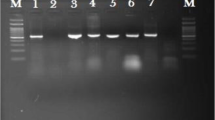Abstract
A study was made on the susceptibility of the cotton leafworm, Spodoptera littoralis (Biosd.), to the nematode, Steinernema carpocapsae (All) and Heterorhabditis bacteriophora. Three concentrations of each nematode species were used (75, 150, and 300 infective juveniles) for each treatment. The nematode, H. bacteriophora, gave 100% mortality 96, 90, and 48 h, respectively, post-treatment of S. littoralis larvae with 75, 150, and 300 infective juveniles. On the other hand, S. carpocapsae (All) gave 100% mortality 120, 90, and 56 h post-treatment, respectively. Therefore, H. bacteriophora was more potent against cotton leafworm than S. carpocapsae. Studies on the infestation intensity of the nematode species against the cotton leafworm showed the predominance of H. bacteriophora over S. carpocapsae, while in studies of the reproductive rate those of S. carpocapsae predominate. The bacterial symbionts of each nematode species were isolated and tested alone against cotton leafworm at concentrations ranging between 1×102 and 5×103 bacterial cells/larva. The results showed a higher activity of Photorhabdus luminescens than that of Xenorhabdu nematophilus.
Similar content being viewed by others
References
Abdel-Razek A (2003) Pathogenic effects of Xenorhabdus nematophilus and Photorhabdus luminescens against pupae of the diamondback moth, Plutella xylostella (L.). J Pest Sci 76:108–111
Abdel–Razek A, Gowen S (2002) The integrated effect of nematode - bacteria complex and neem plant extracts against Plutella xylostella (L) larvae (Lepidoptera: Yponomeutidae) on Chinese cabbage. Arch Phytopathol Pflanzenschutz 35:181–188
Akhurst RJ (1985) The nematode bacterium complex Steinernema glaseri/Xenorhabdus nematophilus subsp. poinarii, pathogenic to root feeding scarab arvae. Proc Aust Conference on Grassl Invertebr Ecol, 4th edn,, pp 262–267
Akhurst RJ (1986) Xenorhabdus, poinarii: its interaction with insect pathogenic nematodes. Syst Appl Microbiol 8:142–147
Boemare NE, Givaudan A (1998) Pathogenicity of the symbionts. In: Simoes N, Boemare N, R-U Ehlers (eds) Pathogenicity of entomopathogenic nematodes versus insect defense mechanism: impact on selection of virulent strains. European commission, Luxembourg ISBN 92 - 828–1, pp 3–7
Bonning BC, Hammock BD (1996) Development of recombinant baculoviruses for insect control. Annu Rev Entomol 41:191–210
Clarke DJ, Dowds BCA (1991) Pathogenicity of Xenorhabdus luminescens. Biochem Soc Trans 20:655
Dunphy GB, Webster JM (1986) Influence of the Mexican strain of Stienernema feltiae and its associated bacterium Xenorhabdus nematophilus on Galleria mellonella. J Parasitol 72:130–135
Dunphy GB, Webster JM (1988) Lipopolysaccharides of Xenorhabdus nematophilus (Enterobacteraceae) and their haemocyte toxicity in non-immune Galleria mellonella (Insecta: Lepidoptera) larvae. J Gen Microbiol 134(4):1017–1028
Dunphy GB, Webster JM (1991) Antihemocytic surface components of Xenorhabdus nematophilus var. dutki and their modification by serum of non-immune larvae of Galleria mellonella. J Invertebr Pathol 58:40–51
Dutky SR, Thompson JV, Cantwell GE (1964) A technique for the mass propagation of the DD-136 nematode. J Insect Pathol 6:417–422
Forst S, Dowds B, Boemare N, Stackbrandt E (1997) Xenorhabdus and Photorhabdus spp. Bugs that kill bugs. Annu Rev Microbiol 51:47–72
Georgis R, Manweiler SA (1994) Entomopathogenic nematode: a developing biological control technology. Agric Zool Rev 6:63–94
Glazer I, Lewis EE (2000) Bioassays for entomopathogenic nematodes. In: Navon A, Ascher KRS (ed) Bioassays of entomopathogenic microbes and nematodes. CAB International, UK, pp 229–249
Gotz P, Boman A, Boman HG (1981) Interaction between insect immunity and an insect pathogenic nematode with symbiotic bacteria. Proc R Lond Soc 212:333–350
Grewel PS (1992): Laboratory techniques for studying insect parasitic rhabditid nematodes. Recent Adv Nematol: 51–66
Hammad SM (1974) Economic agricultural pests of Egypt. Dar - Matpoaar, Alexandria
Homminick WR, Reid AP (1990) Perspectives on entomopathogenic nematology. In: Gaugler R, Kaya K (eds) Entomopathogenic nematodes in biological control. CRS Press, Boca Raton, pp 327–345
Hosny MM, Asim MA, Abo-El-Nasr AA (1976) Insects and animals agricultural pests, 2nd ed. Dar El-Maarf, Cairo, Egypt, 1119 pp.
Kaya HK, Brown LR (1986) Field application of entomogenous nematodes for biological control of clear-wing moth borers in older and sycamore trees of Arboriculture. J Nematology 12(6) 150-154
Kondo E, Ishibashi N (1986) Infectivity and propagation of entomogenous nematodes, Steinernema spp. on the common cutworm, Spodoptera littura (Lepidoptera: Noctuidae). Appl. Ent. Zool. 21 95-108
Morris ON (1985) Susceptibility of 31 species of agricultural insect pests to the entomogenous nematode, Stienernema feltiae and Heterorhabditis bacteriophora. Can Entomol 117:401–407
Mracek Z, Hanzal R, Kordrik D (1988) Sites of penetration of juvenile Stienernematids and Heterorhabditis (Nematoda) into the larvae of Galleria mellonella (Lepidoptera). J Inverteb Pathol 52:477–478
Poinar GO (1983) The natural history of nematodes. Prentice Hall, Englewood Cliffs
Poinar GO, Thomas GM (1967) The nature of Achromobactor nematophilus as an insect pathogen. J Inveteb Pathol 9(4):510–514
Raichon C, Hokkanen HMT, Wearing CH (1994) OECD Workshop on ecological implications of transgenic crop plants containing Bacillus thuringiensis toxin genes. Biocontr Sci Technol 4:395–398
Reardon RC, Kaya HK, Fusco RA, Lewis FB (1986) Evaluation of Stienernema feltiae and Stienernema bibionis (Rhabditida: Steinernematidae) for suppression of Lymantria dispar (Lepidoptera: Lymantidae) in Pennsylvania, USA. Agric Ecosyst Environ 15(1):1–9
Rizk GA, Sheta IB, Gharib AH (1977) The efficiency of Bacillus thuringiensis for control of the cotton leaf worm, Spodoptera littoralis(Boisd). In: Proceedings of the 11 Arab Pesticide Conference, Tanta University
Salama HS, foda MS, El- Sharaby AM (1981) Potency of spore δ-endotoxin complexes of Bacillus thuringiensis against some cotton pests. Z Angew Enomol 91:388–398
Thomas GM, Poinar GO Jr (1979) Xenorhabdus gen. nov. a genus of entomopathogenic nematophilic bacteria of the family Entrobacteriaceae. Int J Syst Bacterial 29:352–360
White GF (1927) A method for obtaining infective juveniles from cultures. Science 66:302–303
Woodring JL, Kaya HK (1988) Steinernematid and Hetrorhabditid nematodes: a handbook of biology and techniques. Southern cooperative series bulletin 331, Arkansas experimental station, Fayetteville, Arkansas
Acknowledgements
This research was supported by the National Research Center, Internal Project No.10/89/5, which was given to the corresponding author.
Author information
Authors and Affiliations
Corresponding author
Rights and permissions
About this article
Cite this article
Abdel-Razek, A.S. Infectivity prospects of both nematodes and bacterial symbionts against cotton leafworm, Spodoptera littoralis (Biosduval) (Lepidoptera: Noctuidae). J Pest Sci 79, 11–15 (2006). https://doi.org/10.1007/s10340-005-0103-8
Received:
Published:
Issue Date:
DOI: https://doi.org/10.1007/s10340-005-0103-8



